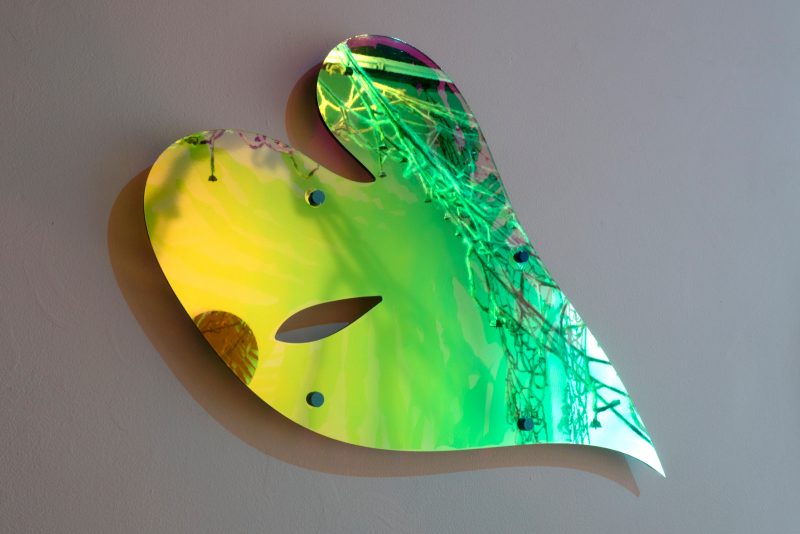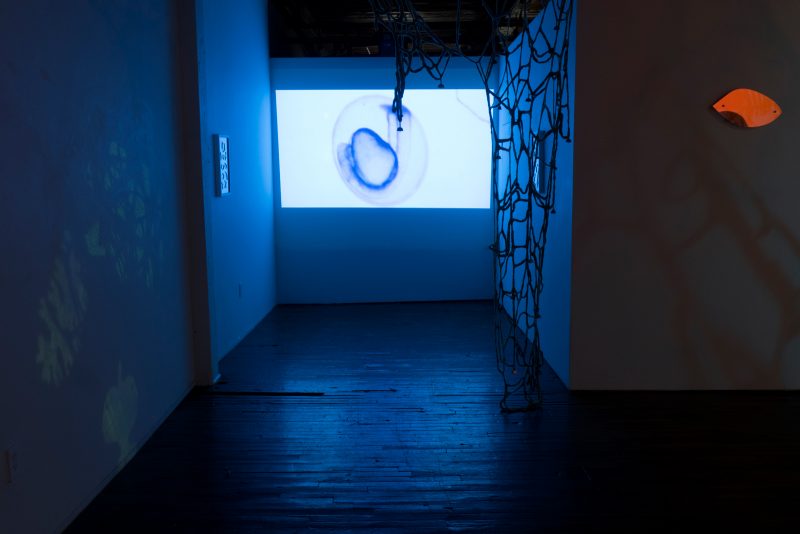Author’s Preface: Based in Philadelphia, Roxana Azar’s works combine photography, collaged and space-age material to explore the intersections of the natural world, science and science fiction. Their work is characterized by speculative flora and a retro-futuristic aesthetic.
In their multidisciplinary practice, GM Keaton creates environments that examine and break down dichotomies between the individual and collective bodies, identities, and experiences specifically through a queer lens. They are completing their MFA at Virginia Commonwealth University in Richmond, VA.

Nature is often the mirror and metaphor for our thoughts, feelings, and desires, seen in poetry and art throughout the ages. A sea at rest reflects a personal equanimity; we see our fear in the shadows of a glade. While the environment and our relationship to nature continues to shift with industrialization, pollution, and landscaping, the romantic, artistic tradition is resistant to changing realities, a true testament to anthropocentrism. What is a mirror if warped? Roxana Azar and GM Keaton provide an answer in their capsule show at High Tide Gallery. The crocus call, like a call and response, describes each artist’s personal reflections on nature while acknowledging and queering the mutating bodies and changing terms of our ecosystems.
As with an installation, none of the pieces are demarcated, inviting the viewer to immerse themselves in the environment lit minimally and primarily by the artists’ projections. Keaton’s work “Akin,” a sprawl of fiber and light, dominates the main space, wool oozing on the floor and dripping in webs from the ceiling. One of their films, “untitled” and a montage of microorganisms, project on Azar’s spare photo-sculptures. The effect is of symbiosis, and furthering the fusion, audio by both artists accompanies the works. Two of Azar’s framed prints flank Keaton’s film “Moonstruck” in a smaller atrium branching from the main gallery.
A massive shag rug culled together from different sheep, “Akin” invites the viewer to sit in its plush wool, a chimeric patchwork of neutrals. Keaton meditates on collective identity—species, cultural, and the like with this piece, and in a way, visitors also become enveloped into the body of the work through touch, and leave a trace of themselves entangled in the fibers. While the wool naturally emits the clean, earthy scent of their origins, “Akin” is an abstraction, an assemblage of sheep, recalling themes of genetic splicing and manipulation. Keaton extends the conceit with hanging felted lattices of wool, hung with small copper livestock bells, resembling a fused herd. Recordings of ringing bells from a moving herd activate the piece; ringing these webs, the visitor joins the flock. The copper bells allude to the artist’s personal experiences around their genderqueer identity and are oxidized in their urine, a bodily fluid commonly used for testing.

The resistance to obvious figurative references describes how the queer body defies the cis and straight appropriating of the natural body. In defiance, new kinds of affinity and community emerge. “Moonstruck” repeats these themes speaking from the perspective of zebrafish. Their genome, similar to humans’, make them ideal for medical exploitation—an ironic failure of interspecies empathy.
Azar’s photos of greenhouse plants shimmer and disappear as one moves through the gallery. Cut into leaf-like and protozoan shapes, the works look like microorganisms in the soup of Keaton’s film, spotted in a petri dish or under a microscope. The images are imprinted in reflective and refractive acrylic, effectively mirrors. The interaction of projections and mirrored photographs casts luminescent doublings of Azar’s images of the walls and shadowy reflections of Keaton’s fibrous drapes. The entanglement between the two artists’ works suggests a reciprocal ecosystem while the multiplication of immaterial images invokes a spiritual dimension, amplified by the background sound. One of Azar’s inspirations was Cleve Baxter’s exploration of plant-intelligence, telepathic abilities, and sensory perception. Plants were hooked up to polygraph machines and tested for various reactions: in one, a plant registered the death of a shrimp. In an update, Azar provides a MIDI Sprout recording of a Calathea Musaica plant, orchestrating the music, so to speak, with various interactions—the gallery quite literally resonates with the plant’s voice. Complementing Keaton’s deconstruction of flesh and form, Azar’s work is a quiet explosion of internal life, speculating on emotional and psychic spectrums outside of normative definitions.
Azar’s actual photos are often denser arrangements of leaves, branches, and flowers intended to draw comparisons to cellular landscapes. Images only reveal themselves from specific angles, creating a dissonance between the simple organic shapes and their contents. Working off the same concept, Azar accompanies these works with framed images but in stylistic inverse: simple shapes like eyes, algae and leaves stamped out of photographs. In the dissonance between form and image, Azar attempts to capture the tension and play between the plants’ inner subjectivity, the vitality of flora and the framework of her memory. The opalescent, holographic quality of Azar’s work gives them a sheen of a smart screen while simulating the glass of the greenhouses they depict. The deliberately technological and artificial view of plants—in greenhouses literally cultivated outside of nature—questions our organic assumptions of nature. Azar reorients subjectivity to nature, implanting staring eyes into their foliage. Are we the ones they are seeing in the mirror, behind the glass?
Each day, the environment around us becomes less and less unmediated, less wild, irreversibly changed. In the cultural landscape, things that have long been seen as intrinsic—gender, sexuality, social identity, the chemical integrity of the human body—have evolved in the last decade as queer communities have become more emerged and begun to merge with the mainstream. In turn, these shifts in norms have come under interrogation in recent years, often around the question of whether they are ‘natural’. Keaton and Azar’s exhibition, both in materials and content, recognizes the artificiality in our fixed definitions of both nature and of ourselves. At the same time, this artificiality doesn’t preclude the sense of transcendence, of wonder, beauty or empathy. It affirms it and gives it the capacity to expand into ever stranger, greater, mutable modes of beauty.
“The crocus call,” Roxana Azar & GM Keaton (NOW CLOSED)
High Tide, 1850 N. Hope St, Philadelphia PA 19122










